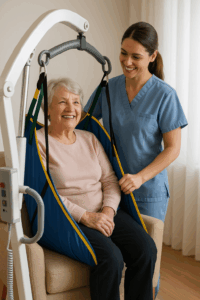
By Team Seaglass

The Real Benefits: They’re Better Than You Think!
What This Means for Your Residents:
- Smoother, more comfortable transfers that reduce discomfort and anxiety
- Studies show that mechanical lifts can reduce transfer-related pain by up to 40%
- Better safety – research indicates that proper lift use can decrease fall incidents during transfers by 50% or more
- The dignity of a controlled, professional transfer versus the awkwardness of being manually lifted
What Families Gain:
- Real peace of mind backed by data: facilities using lift programs see injury rates drop by 50-95%
- Staff turnover in facilities with safe resident handling programs decrease by up to 60%, meaning more familiar faces caring for your loved one
- Lower facility liability costs often translate to stable pricing
- Care that follows the American Nurses Association’s position that manual lifting should be eliminated
How to Build Genuine Acceptance and Trust
Transparent Communication– Host friendly “demo” sessions where residents and families can see the lifts in action, ask questions, and even try sitting in a sling themselves. When people understand that today’s lifts are designed for comfort – with padded slings, smooth hydraulics, and adjustable positioning – they’re much more open to using them.
Give Residents a Voice– Choice is powerful! Let residents pick their sling style (there are multiple options!), decide whether they want to practice with the lift before it’s truly needed, or choose what music plays during the transfers. Facilities implementing choice-based approaches report up to 75% improvement in lift acceptance within the first month.
Make Your Staff the “Champions”- Your team sets the tone for everything. Invest time in training that covers not just the mechanics of lift usage, but also how to explain the benefits of this technology reassuringly. When staff approach lifts with confidence and positivity – residents and family will be less anxious.
Create Positive First Experiences– Introduce lifts gradually, with extra time for initial resident transfers. Pair nervous residents with staff who excel at building rapport, and encourage successful users to share experiences with peers.
Address Independence Concerns– Reference lifts as tools that enable continued resident independence, not taking independence away from the resident. Research shows that 20-30% of people who fall suffer moderate to severe injuries that can lead to permanent mobility loss. Lifts prevent this devastating cascade.
Making it Standard Practice
The key to long-term success is making mechanical lifts the standard of care, not an exception. When lifts are positioned as the normal, professional way transfers are done – like taking blood pressure or temperature at the doctor’s office – resistance diminishes. Include lift usage expectations in admission agreements, tour discussions, and care plan meetings from day one.
By prioritizing both physical and emotional comfort, senior living communities can create a culture where mechanical lifts are embraced as what they are: essential tools that honor dignity while protecting health.

